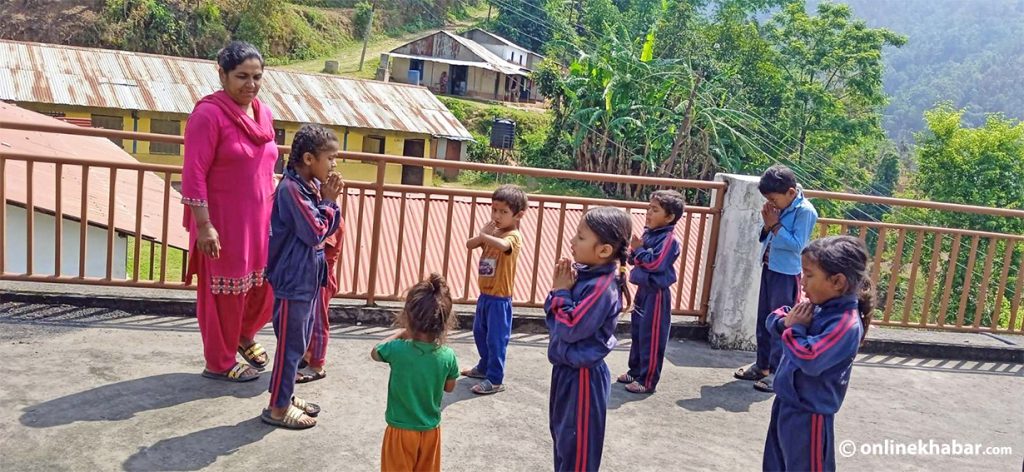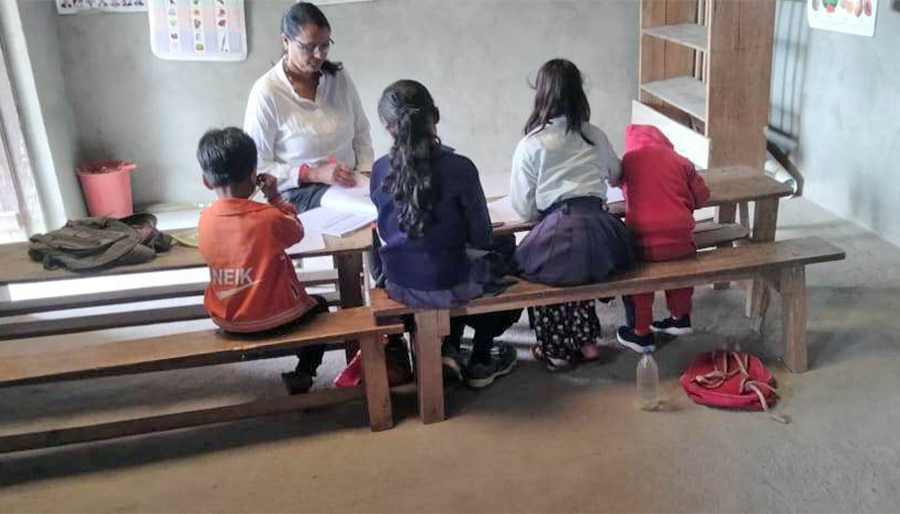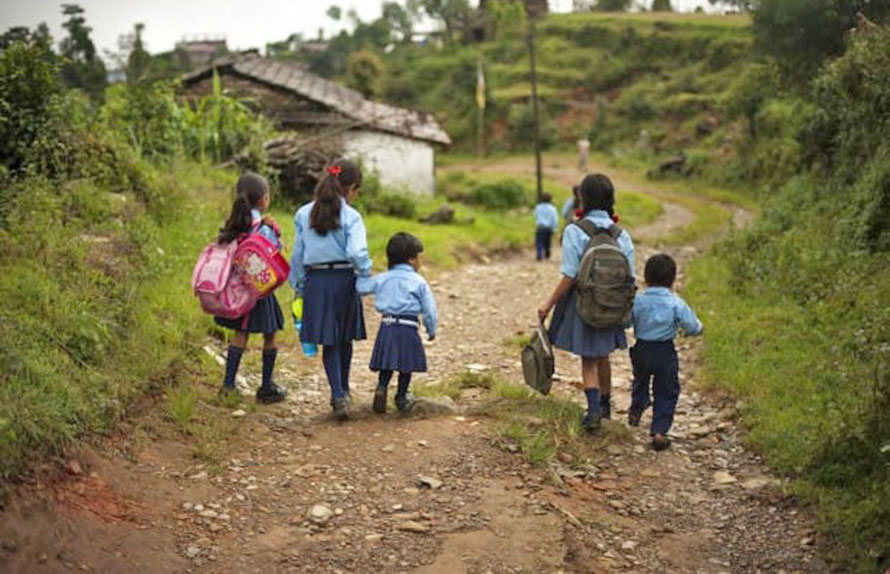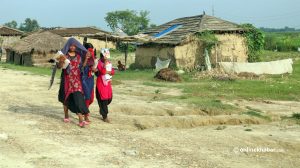
Devi Basic School in Ilam got only five students enrolled last academic season.
According to the school’s principal Champadevi Bhandari, seven students enrolled for the academic year initially, but two of them went to another school.
Likewise, only five students enrolled in Devi Basic School (grades one to five) in Ilam.
Radhika Ghimire, an education section officer of the Ilam municipality, says Devi and Sidhdhadevi are not the only schools in her jurisdiction that received fewer students. According to her, 16 students got enrolled in Jaleshwari Basic School nearby.
Although under a municipal government, these schools are located in rural parts in difficult terrain, Ghimire explains, adding she fears the numbers may go even lower in upcoming years.
Schools in rural Nepal, mainly in hilly areas, have started to face a decrease in the enrolment of students. While the problem has mainly plagued public schools, some private schools have also begun to feel the pressure.
Key reasons

According to the local governments, the main reason for the decrease in the number of students in schools in rural Nepal is the decrease in the birth rate. The second reason is migration and the concentration of people in cities.
Section officer Ghimire says that although the number of students in these schools in rural Nepal is decreasing every year, there is a compulsion to conduct classes as they cannot be merged either due to the distance between them.
According to Bhandari, politics at the local level is also responsible for the decrease in the number of students in these schools. Bhandari says, “Migration can be seen as one of the obvious reasons for the low number of students, but mostly it is happening for political gain where representatives of local units are transforming teachers as they wish and doing dirty politics in education.”
Education officer Surakshya Chapagai in the Laligurans municipality of Tehrathum says that community schools in her area are also facing the same problem. “The number of students is decreasing by 15 to 20 per cent every year.”
Similarly, the schools in Bhojpur municipality, Darchula municipality and Gorkha municipality are also facing the same problem.
In Bhojpur, there are seven basic schools with 12 to 30 students each, informs Padam Bahadur Pradhan from the education, youth and sports department of the municipality.
The number of new admissions is decreasing in the Apihimal rural municipality of Darchula. Education Officer Birendra Saud says that in the upper grades, the number is around the same as in 2019/2020. He says, “But the number of students enrolling in lower grades is decreasing every year.”
In the municipalities of Darchula, the number of students enrolled in early childhood development classes is decreasing by five to seven per cent every year. Education officer Saud says that due to the decrease in birth rate and migration, the enrollment rate at the lower grades is decreasing, which will gradually lead to the problem of not getting students at the upper level. He says, “These same students will go to higher class tomorrow and if there is less number in lower classes, it will affect the upper classes in the long run.”
The low number of students in schools in rural Nepal is directly related to the country’s population growth rate. According to the national population census 2021, the population growth rate in the municipality is 1.36 per cent. While the overall population growth rate is 0.92 per cent, the population growth rate in the rural area is limited to 0.11 per cent.
According to Nebin Lal Shrestha, the director general at the National Statistics Office, 19 million and 296,788 (66.2 per cent) of the population live in the municipalities out of 29 million 164,588 total population. The population living in rural municipalities is 9 million 876,790 (33.8 per cent).
This is a significant change when compared to the census of 2011. In 2011, 17.1 per cent of people lived in cities and 82.93 per cent of people lived in villages. After the country became a federal democratic republic, the number of municipalities increased to 293 from 58.
Failed solutions

In such a case, the government rules allow schools in rural Nepal to conduct residential public schools in a location that is accessible to all.
However, this solution does not seem to be practical at all, due to the reluctance of parents to send their kids to residential education programmes.
“In 2021, Durgali Basic School and Aamilas Secondary School were merged with the residential programme for the students,” Ram Nath, the head of the education section in Gaumul rural municipality of Bajura says, “But students denied to stay in the school.”
According to him, the residential programme failed though it was expected to enhance the student’s education.
He says, “Parents in rural areas do not have the confidence to keep their children outside the home. Apart from that, they also do not want to lose the help they receive from children for household chores.”
Meanwhile, concerned local governments have started merging schools in rural Nepal as authorised by School Integration and Integration Program Implementation Procedure, 2020.
There are certain criteria under the procedure, and different numbers of students have been fixed to decide on mergers. The numbers are different from region to region.
But the local governments say the merger efforts have not been successful due to the long distances between them.
Local efforts

As the number of students in public schools in rural Nepal is decreasing, the local governments have started adopting various measures. They are promoting local schools through various campaigns and making it mandatory to enrol people’s representatives and government employees’ children in local schools. They have begun teaching in English and providing transportation facilities.
For example, Bhimsen Thapa rural municipality of Gorkha has urged all local government officials to enrol children in community schools. The decision, however, is not implemented. Anbukhaireni rural municipality in the neighbouring Tanahun district has followed suit.
“According to this agreement, all the representatives of the rural municipality have to enrol their children in public schools,” says Nirmala Kunwar, the head of the Education, Youth and Sports Section in the rural municipality.
Basant Joshi, the education officer in Chautara Sangachokgadhi municipality of Sindhupalchok, says most community schools in Chautara have also launched English-medium classes. “Nowadays, parents and children are fascinated towards the English language. Therefore, we have initiated for English medium in schools as much as possible,” he says, “As most of the schools in the market area are in English medium, and the number of students is increasing there.”
In order to increase the number of students, the Bhimsen Thapa rural municipality of Gorkha is also preparing to arrange transport for students of lower grades.
Teacher Ramesh Rai says that if the municipalities do not find such a solution, many schools in rural Nepal will be closed in a few years. He says, “If the municipalities do not work to raise the educational quality and create an environment for the people to live in the village, not only the schools but also the villages will be empty in the next decade.”
However, according to Ram Gurung, a sociologist and community education scholar, the rule that the children of people’s representatives and employees should be admitted to public schools in rural Nepal increases the risk of admission only for the sake of statistics. According to Gurung, there is a big difference between the government data and the actual number of students in public schools.
He says, “They enrol the kids in the community schools in rural Nepal, but they teach them in some schools in the market. And they send them to community schools only on exam days.”
Instead, he says that local governments should study how to create a place where children can be educated easily. He says, “I see that it will be effective if residential schools in rural Nepal are operated after analysing all the cultural, economic, community and age groups of the students.”
This story was translated from the original Nepali version and edited for clarity and length.


























